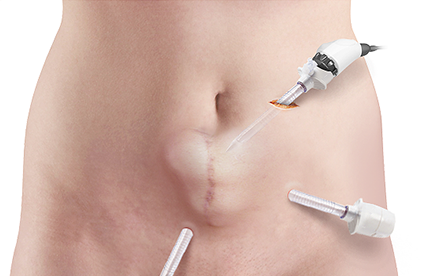Hernia Repair

Introduction to Hernia
A hernia is a sac formed out of lining of an organ that comes through the hole or weak area in the wall of a muscle, tissue, or membrane that normally holds an organ in place. Hernias are more common in certain parts of the body such as the abdomen, groin and upper thigh area, and belly button area. They also can occur in any place where you have had an incision from surgery.
Types of Hernia
There are different types of hernias based on their location. The most common types are listed above.
- Inguinal Hernia
It appears as a bulge in the groin or scrotum, occurring more commonly in men than women. - Femoral Hernia
A femoral hernia appears as a bulge in the upper thigh, is a loop of intestine, or another part of the abdominal contents, that has been forced out of the abdomen through a channel called the “femoral canal” (a tube-shaped passage at the top of the front of the thigh). This type of hernia tends to occur in older people and is more common in women than in men. - Hiatus Hernia
A hiatus hernia is when part of the stomach slides through the diaphragm, the muscular sheet that separates the lungs and chest from the abdomen. - Incisional Hernia
Incisional hernia may be caused by the scar if you have had abdominal surgery. - Umbilical Hernia
Umbilical hernia is a small bulge around the umbilicus (belly button). An umbilical hernia in an infant is caused by the incomplete closure of the muscles around the umbilicus.
Treatment of Hernia
Hernia will not get better by itself and may need to be treated surgically as they have a high risk of becoming strangulated. A hernia repair is usually performed as an outpatient surgery with no overnight stay in the hospital. The operation may be performed as an “open” or “keyhole” (laparoscopic) surgery.
In open hernia repair, a large incision is made on the groin (abdomen) and the bulge is pushed back into place. Laparoscopic hernia surgery is a surgical procedure in which a laparoscope is inserted into the abdomen through a small incision. The laparoscope is a small fiber-optic viewing instrument attached with a tiny lens, light source and video camera.
Indications and Contraindications for Hernia Repair Surgery
Indications for hernia repair surgery may include recurrent hernias, bilateral hernias, and the need for earlier return to full activities.
Contraindications specific to hernia surgery include non-reducible inguinal hernia, previous peritoneal surgery, and inability to tolerate general anesthesia.
Medical conditions including upper respiratory tract or skin infection and poorly controlled diabetes mellitus should be fully addressed and the surgery should be delayed accordingly.
Advantages of Hernia Repair Surgery
- Less post-operative pain and smooth recovery
- No further incisions required for patients with hernias in both groins (bilateral hernia)
- Ideal method for patients with recurrent hernias after previous surgery
- Early discharge from hospital
- Earlier return to work
Procedure
Hernia repair surgery is performed in a hospital operating room. You may be given a general anesthesia. The surgeon makes small incisions over the abdomen and adjusts the bulge back in place by pushing it inside. Then the incisions are closed and dressed in a sterile bandage.
Risks and Complications of Hernia Repair Surgery
Specific complications of hernia surgery may include local discomfort and stiffness, infection, damage to nerves and blood vessels, bruising, blood clots, wound irritation and urinary retention.
Post-Operative Guidelines
- Pain medication will be provided and should be taken as directed
- Remove the bandage after 24 hours
- Swelling in the groin, at the site of hernia may occur due to serum accumulation in the cavity left by reducing the hernial sac
- Bruising usually appears in the genital area, which is not painful and disappears over 1-2 weeks
- You may drive and resume normal activities when comfortable unless otherwise instructed
- Make a follow up visit 7 to 10 days after surgery to monitor your progress



